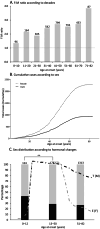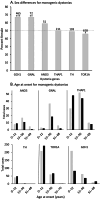Sex Differences in Dystonia
- PMID: 38778444
- PMCID: PMC11329567
- DOI: 10.1002/mdc3.14059
Sex Differences in Dystonia
Erratum in
-
Correction to "Sex Differences in Dystonia".Mov Disord Clin Pract. 2024 Nov;11(11):1470. doi: 10.1002/mdc3.14217. Epub 2024 Sep 23. Mov Disord Clin Pract. 2024. PMID: 39313914 Free PMC article. No abstract available.
Abstract
Background: Prior studies have indicated that female individuals outnumber male individuals for certain types of dystonia. Few studies have addressed factors impacting these sex differences or their potential biological mechanisms.
Objectives: To evaluate factors underlying sex differences in the dystonias and explore potential mechanisms for these differences.
Methods: Data from individuals with various types of dystonia were analyzed in relation to sex. Data came from two different sources. One source was the Dystonia Coalition database, which contains predominantly idiopathic adult-onset focal and segmental dystonias. The second source was the MDSGene database, which contains predominantly early-onset monogenic dystonias.
Results: The 3222 individuals from the Dystonia Coalition included 71% female participants and 29% male participants for an overall female-to-male ratio (F:M) of 2.4. This ratio varied according to body region affected and whether dystonia was task-specific. The female predominance was age-dependent. Sex did not have a significant impact on co-existing tremor, geste antagoniste, depression or anxiety. In the 1377 individuals from the MDSGene database, female participants outnumbered male participants for some genes (GNAL, GCH1, and ANO3) but not for other genes (THAP1, TH, and TOR1A).
Conclusions: These results are in keeping with prior studies that have indicated female individuals outnumber male individuals for both adult-onset idiopathic and early onset monogenic dystonias. These results extend prior observations by revealing that sex ratios depend on the type of dystonia, age, and underlying genetics.
Keywords: blepharospasm; dystonia; sex differences; spasmodic dysphonia; writer's cramp.
© 2024 International Parkinson and Movement Disorder Society.
Figures





References
-
- Warner TT. Sex‐related influences on the frequency and age of onset of primary dystonia. Neurology 1999;53:1871–1873. - PubMed
-
- Rafee S, O'Riordan S, Reilly R, Hutchinson M. We must talk about sex and focal dystonia. Mov Disord 2021;36:604–608. - PubMed
-
- Jinnah HA, Sun YV. Dystonia genes and their biological pathways. Neurobiol Dis 2019;129:159–168. - PubMed
MeSH terms
Substances
Grants and funding
LinkOut - more resources
Full Text Sources
Medical

